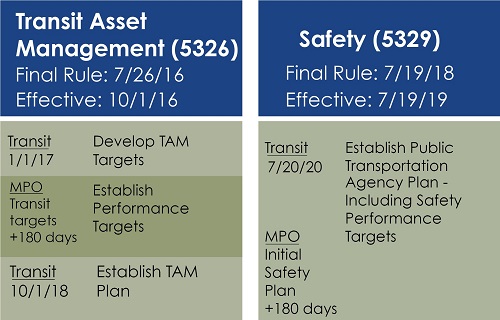Timeframes for Performance Based Planning

FTA and FHWA are establishing the performance management framework through a series of six rules, each of which contains requirements and deadlines for transit providers, MPOs, and state DOTs. See milestones from the Statewide and Nonmetropolitan Transportation Planning and Metropolitan Transportation Planning and Transit Asset Management Final Rules above, and in more detail below.
Learn more about performance-based planning for transit.
Roles & Requirements for Performance-Based Planning
Transit Providers
Transit providers are responsible for state of good repair (SGR) and safety performance targets. Transit providers have three months from the effective date of the Transit Asset Management (TAM) Final Rule -- October 1, 2016 -- to set SGR targets by class for the next fiscal year. Targets must be reset each year.
Transit providers will have two years from October 1, 2016, when the TAM Final Rule became effective, to develop their TAM plans. They must update their TAM plan at least every four years, and should share their TAM plan, supporting documents of performance targets, investment strategies, and an annual condition assessment to the state and Metropolitan Planning Organization that provides its funding. (49 CFR§625.53).
The transit provider must submit an annual data report to the NTD that reflects the SGR performance targets for the following year and condition information for the provider's public transportation system. The transit provider is also required to submit an annual narrative report to the NTD that provides a description of any change in the condition of the provider's transit system from the previous year and describes the progress made during the year to meet the performance targets set in the previous reporting year (49 CFR§625.55).
The National Public Transportation Safety Plan guides the national effort in managing the safety risks and safety hazards within our nation’s public transportation systems. It establishes performance measures to improve the safety of public transportation systems that receive federal financial assistance. The Public Transportation Agency Safety Plan Final Rule requires each transit agency or state DOT to establish and self-certify its initial Public Transportation Agency Safety Plan by July 20, 2020. One of the required elements of that plan is establishing safety performance targets. Public Transportation Agency Safety Plans will need to be re-certified annually.
Metropolitan Planning Organizations
MPOs have 180 days from the establishment of the transit provider TAM targets to establish performance targets that address the performance measures or standards established under 23 CFR part 490 (where applicable), 49 U.S.C. 5326(c), to use in tracking progress toward attainment of critical outcomes for the region of the metropolitan planning organization (49 CFR§450.306(d)).
MPOs will have one year from the establishment of the transit agency safety targets to establish performance targets that address the performance measures or standards established under 23 CFR part 490 (where applicable),and 49 U.S.C. 5329(d) to use in tracking progress toward attainment of critical outcomes for the region of the metropolitan planning organization ( 49 CFR§450.306(d)).
180 days after the State DOT establishes its performance targets, or approximately 18 months after the 150(c) rule is finalized, the MPO will be required to establish their performance targets. Also, by statute, the MPO is directed to coordinate to the maximum extent possible with the State DOT and public transportation providers when setting performance targets required under 49 U.S.C. 5326(c) and 5329(d) (49 CFR§450.206(c)(2), 49 CFR§450.306(d)(2)(ii)), and 49 CFR§450.306(d)(3)(iii)).
State Departments of Transportation
When the Federal Highway National Performance Management Measures rule, (150(c)) is finalized, each state DOT will have one year to establish performance targets. The State DOT is directed to coordinate with the MPOs when selecting targets addressing the performance areas under 23 U.S.C. 150(b) and 23 CFR§490 to ensure consistency to the maximum extent possible (49 CFR§450.206(c)(2), 49 CFR§450.306(d)(2)(ii)).
